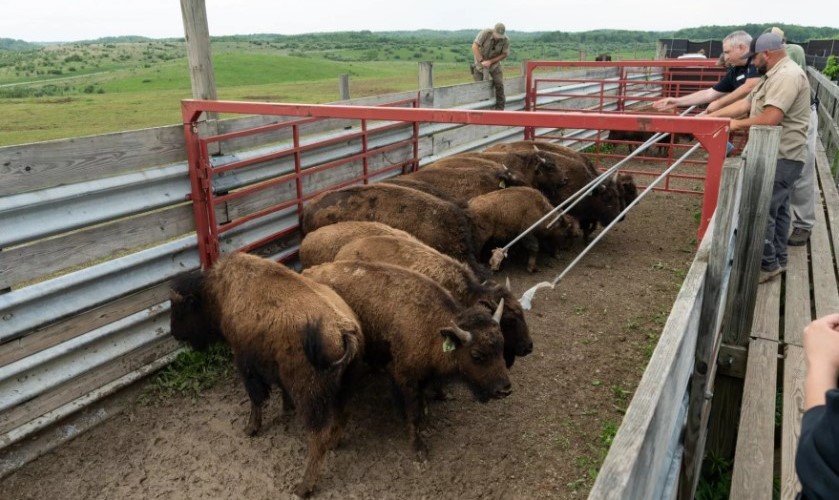EAGLE BUTTE, S.D. – As the saying goes one person’s loss is another person’s gain.
When Grand Canyon National Park in Arizona had 100 more bison than could be maintained, the Cheyenne River Sioux Tribe seized the opportunity.
With the help of the InterTribal Buffalo Council – or ITBC – the animals were successfully transported hundreds of miles to the CRST reservation.
Jayme Murray is the CEO of the Cheyenne River Sioux Tribe Buffalo Authority Corporation. He said the bison are going towards feeding children on the reservation.
“A lot of these donated animals we put towards our farm to school program. We’re bringing beef as well as bison into [the Cheyenne River Sioux Tribe’s] reservation schools, and we’ve actually branched out to schools on other reservations in South Dakota last year,” Murray said. “But since the animals are donated, the ones that are what we call harvest ready we can butcher right away. We’re able to process those and turn around and sell that meat to the schools for the cost of processing basically.”
Murray said last year the meat was able to sell as low as $3 per pound.
Greg Holm is the Wildlife Program Manager of the Science and Resource Management Division for the park. He said these 100 have some genetic differences from typical bison.
“We’re pretty transparent with the tribes that this herd of bison was brought to Arizona in the early 1900s. They were bred with cattle at one point to try and make a hearty stock animal,” Holm said. “It didn’t work out, but as a result, our bison do have a genetic marker for cattle. They aren’t cattle, they don’t look like them, they don’t behave like them. They just have a marker in their genes that said at some point great-great-great-grandma was introduced to a cow.”
Due to the markers – Murray says this particular set of bison won’t be used to breed with the CRST’s existing herd.
Thomas Peters is the Technical Services Assistant for the InterTribal Buffalo Council. He said it’s special to see the animals return to the tribes on the Great Plains.
“Especially the tribes on the Great Plains. They have a really close connection and tie with these animals. You know, they’ve been living out here with them for thousands and thousands of years,” Peters said. “In the 1800s the population was completely decimated. There’s a lot of tribes that they didn’t have any bison around. They couldn’t rely on them to watch and see their social structures, for some tribes, to do that as a food source, as a means of shelter, and all of that stuff.”
Holm said this is part of the park’s efforts to ease some past tensions.
“One hundred is the most we’ve ever sent, and it’s great they could all go to one spot. We’ve given animals to the Cheyenne River Sioux in previous years, but not that many. And so, we’ll continue our relationship with ITBC,” Holm said. “In the meantime, we are also trying to work with our local tribes to see if we can provide a similar service to them if they have any interest in bison at Grand Canyon. That’s another thing. I think the park wasn’t as inclusive when we started short-term reduction, and I think we’re well aware that we need to do a better job of that now.”
Thomas Peters from the ITBC said collaborations between the three parties like this one is helping to heal some scars.
“Tribes being able to restore this connection and get these animals out there, there’s going to be a push to have more access for them and get them more into a situation where they can move more freely than being in a pasture. It has a possibility of opening up avenues to restoring land that was stolen with the Dawes Act and any of that kind of stuff,” Peters said.
The Cheyenne River Sioux Tribe’s Jayme Murray said seeing the animals back feels right for both the tribes and the animals.
“It’s a neat dynamic how quickly they adapt to their natural setting. We’ve had similar things with animals we’ve gotten from the East that we’ve brought back. It’s kind of amazing how they just immediately, it’s almost like they feel at home,” Murray said. “It’s a pretty cool dynamic. To get them into more of maybe their historical range, it’s pretty cool and I think you can see it in the animals. It’s kind of hard to explain, but they definitely feel at home when they get here.”
Murray said the tribe will continue to look for more opportunities to bring bison back to the Great Plains.


